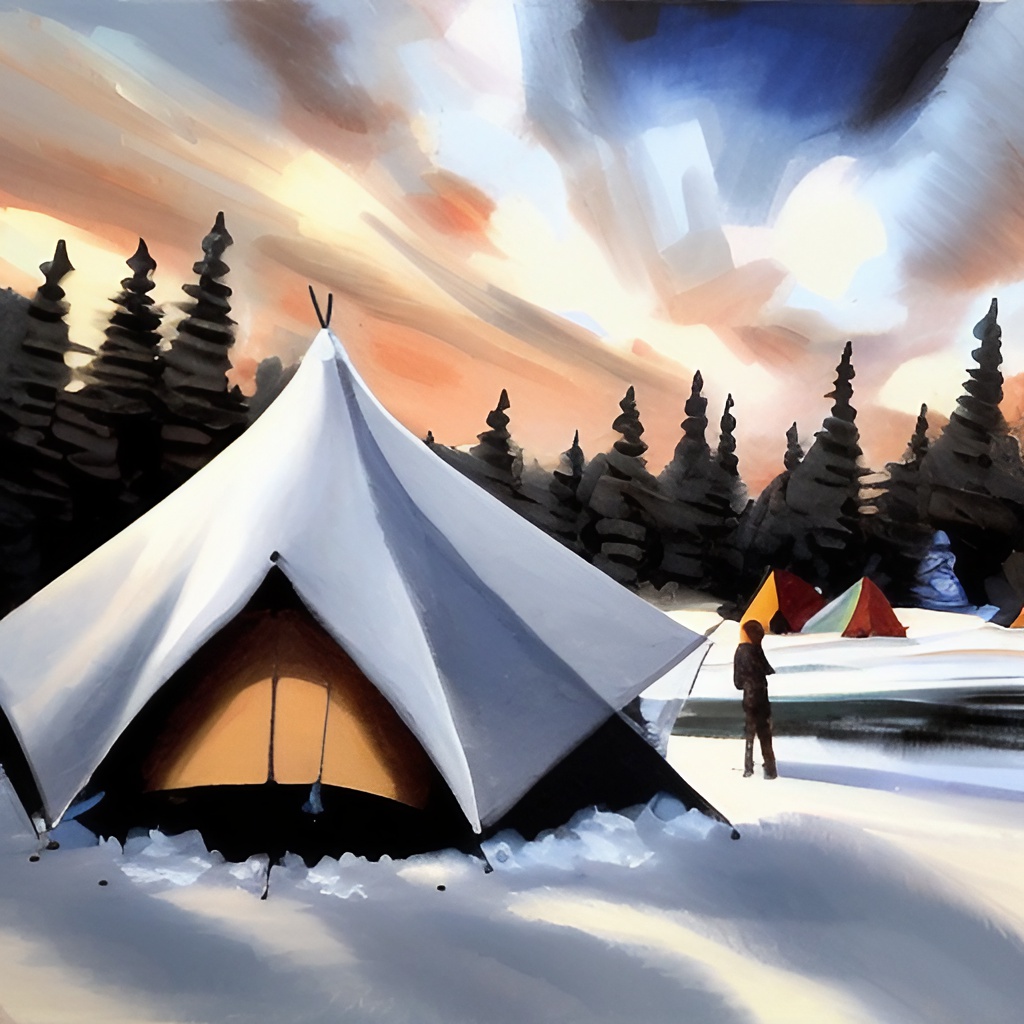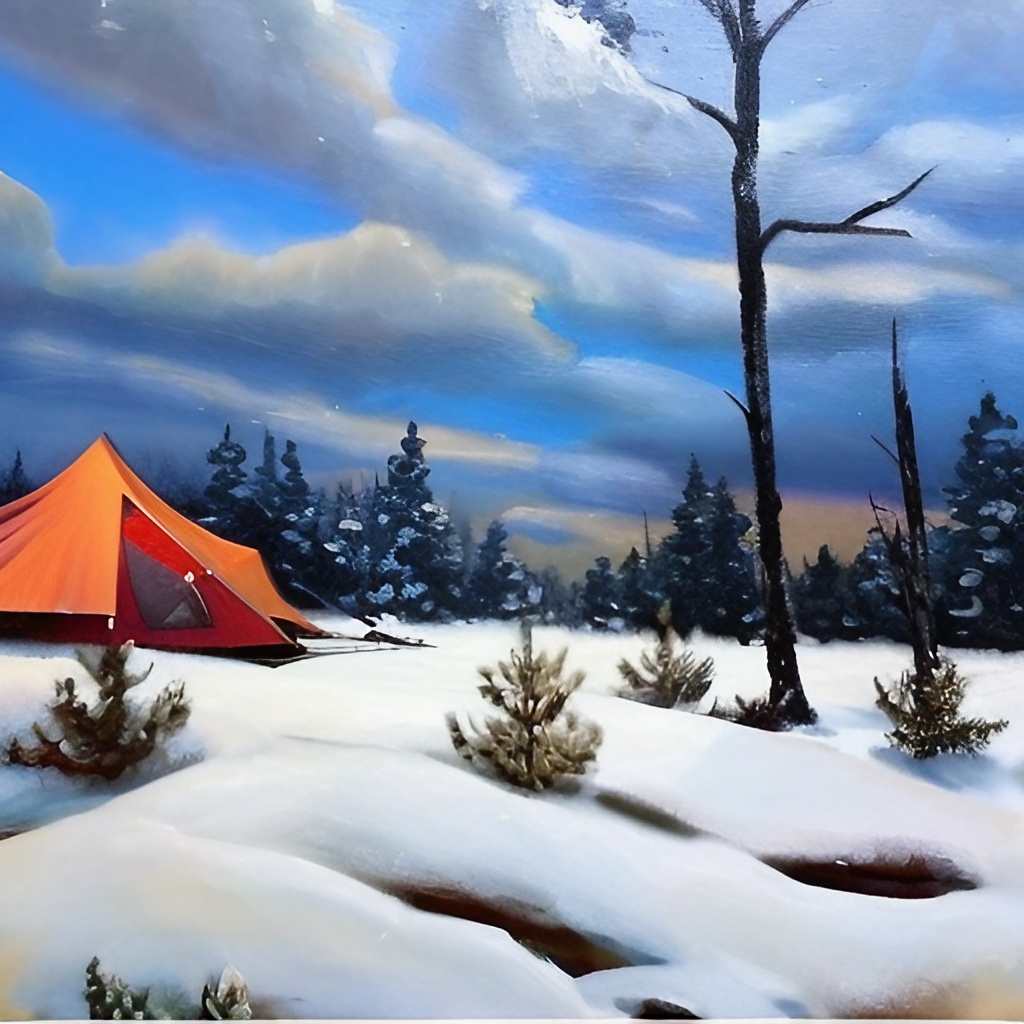
After 11+ hours of research, we chose the FLYTOP 1-2-person Backpacking Tent as the best insulated tent.
With the dawn of insulated tents, camping enjoyment no longer hinges on the forecast of fickle weather.
Whether camping in frigid winter temperatures or the dog days of summer, insulated tents maintain their interior temperature to keep you comfortable.
To help you maximize your camping trip – regardless of the weather – we sifted through the available insulated tents to bring you our favorites list.
We found that the best insulated tent is the FLYTOP 1-2-person Backpacking Tent.
It also happens to be our favorite for summer camping. Featuring an aluminum coating, you can rest assured that the sun’s harmful UV rays and scorching heat will be deflected.
Not to mention, the FLYTOP performs in the winter, too, insulating campers down to 20 degrees. Lastly, you’re getting all this at an extremely light price and weight.
For car campers seeking a larger tent and having the corresponding budget, we loved the Crua Outdoors Duo Combo Maxx 3-Person Tent. This 2-piece system features an inner cocoon and an outer tent. They can be used together or separately for ultimate insulation and weather protection.
- Top Recommendations – The 8 Best Insulated Tents
- 1. The FLYTOP 1-2-person Backpacking Tent – The 8 Best Insulated Tents
- 2. The Crua Outdoors Culla 2-Person Cocoon Tent – The 8 Best Insulated Tents
- 3. The Crua Outdoors Duo Combo Maxx 3-Person Tent – The 8 Best Insulated Tents
- 4. The ALPS Mountaineering Tasmanian 2-Person Tent – The 8 Best Insulated Tents
- 5. The SE Emergency Outdoor Tube Tent – The 8 Best Insulated Tents
- 6. The Kodiak Canvas Flex-Bow Tent – The 8 Best Insulated Tents
- 7. The CLAM 14478 C-890 6-Person Pop-Up – The 8 Best Insulated Tents
- 8. The THUNDERBAY 6-Person Insulated Ice Fishing Tent – The 8 Best Insulated Tents
- How to Choose the Best Insulated Tent – The 8 Best Insulated Tents
- Group Size – How to Choose the Best Insulated Tent
- Amount of Insulation Required – How to Choose the Best Insulated Tent
- Overall Weather Protection – How to Choose the Best Insulated Tent
- Shape – How to Choose the Best Insulated Tent
- Materials – How to Choose the Best Insulated Tent
- Ventilation – How to Choose the Best Insulated Tent
- Conclusion: Final Verdict – The 8 Best Insulated Tents
- Frequently Asked Questions – The 8 Best Insulated Tents
- 1. What are Insulated Tents, and How Do They Work? – FAQs
- 2. Why Would I Need an Insulated Tent? – FAQs
- 3. How Do I Choose the Right Size Insulated Tent for my Needs? – FAQs
- 4. Are There Different Types of Insulation Materials Used in Tents? – FAQs
- 5. What are the Benefits of Using an Insulated Tent? – FAQs
Top Recommendations – The 8 Best Insulated Tents
Best for Winter Camping – Top Recommendations
- Crua Outdoors Culla 2-Person Inner Cocoon Tent — transform any tent into an insulated cocoon
- Crua Outdoors Duo Combo Maxx 3-Person Tent — highly versatile 2-piece system
- ALPS Mountaineering Tasmanian 2-Person Tent — a shelter for the dedicated mountaineer who requires the ultimate in performance
Best for Summer Camping – Top Recommendations
- FLYTOP 1-2-person Double Layer Backpacking Tent — a small but mighty option with UV protection for hot summer camping
- Kodiak Canvas Flex-Bow Tent — long-lasting and durable canvas option
Most Lightweight – Top Recommendations
- SE Emergency Outdoor Tube Tent — minimalist shelter for mild or temporary use
Best for Extended Winter Base Camps – Top Recommendations
- Kodiak Canvas Flex-Bow Tent — long-lasting and durable canvas option
- CLAM 14478 C-890 6 Person 11.5 Foot Lightweight Portable Pop Up — instant setup for hassle-free pitching on the ice or campground
- THUNDERBAY 6-Person Insulated Ice Fishing Tent — the largest amount of space for an affordable price
We also created a helpful buyer’s guide to help you decide which insulated tent is best for you.
1. The FLYTOP 1-2-person Backpacking Tent – The 8 Best Insulated Tents
- Space & comfort (30%) – 7/10, too small for 2 campers, good for 1
- Insulation/weather resistance (25%) – 8/10, held up to a variety of hot, cold, and soggy conditions
- Build quality and durability (15%) – 7/10
- Ease of setup (10%) – 8/10
- Weight & Portability (10%) – 8/10, 5.9lbs is acceptable for backpacking
- Company history and reputation (10%) – 6/10, not well known
Best for: a camper looking for a lightweight summer tent to keep cool on the hottest days; $
So you’re looking for a well-insulated tent to keep you cool in the summer. But there’s one problem: all the options you’ve encountered are heavy-duty and too overbuilt.
Well, the FLYTOP 1-2-person Backpacking Tent just might be what you’re looking for. Not only is this tent ideal for summer trips, but it can stand up to tough winter conditions too.
For camping in the dog days of summer, the FLYTOP offers stellar UV protection through a silver coating that blocks 98% of the sun’s rays.
Doing so reflects heat, so you stay cool inside, even in direct sunlight. Several campers appreciated this when camping on a few scorching hot days.
But the FLYTOP isn’t just for when the sun is shining. It’s definitely proven its worth through rain and even the winter’s chill.
Some users mentioned taking this tent out on 20-degree nights, where it kept them quite warm.
Others said they left it unattended through several cycles of freezing, thawing, sleet, and snow. Yet the inside of the FLYTOP remained dry.
Given the tent’s impressive specs, we shouldn’t be so surprised at this performance.
The tent body is constructed with a rugged 210D Oxford fabric. The seams are fully taped to prevent rain from leaking inside. And the rainfly is rated to an impressive 4,000HH.
The biggest downside is that it’s probably too small for the advertised 2 people.
With a floor width that barely brushes 5’, you’d have to be cozy to share this tent with a buddy.
Pros – The FLYTOP 1-2-person Backpacking Tent
- Features UV protection to keep you cool; ideal for campers with sensitive skin
- Insulates in winter conditions; tested through 20-degree nights
- 5.9lbs makes this tent acceptable for backpacking; not overbuilt and is perfect for all adventures
- 2 small vestibules for storing a pack or cooking
Cons – The FLYTOP 1-2-person Backpacking Tent
- Too small to fit the advertised 2 people
2. The Crua Outdoors Culla 2-Person Cocoon Tent – The 8 Best Insulated Tents
- Space & comfort (30%) – 7/10, a bit small for the advertised 2 campers
- Insulation/weather resistance (25%) – 7/10, not waterproof at all unless you use a separate cover but comes with superior insulation properties
- Build quality and durability (15%) – 8/10
- Ease of setup (10%) – 8/10
- Weight & Portability (10%) – 6/10, 15lbs makes this a car camping tent
- Company history and reputation (10%) – 8/10
Best for 1-2 smaller car campers who want to insulate their favorite tent for all sorts of extreme weather; $$$
Have you ever wished you could transform your favorite 3 season tent into something warm enough to handle tougher temperatures?
Now you can with the Crua Outdoors Culla 2-Person Cocoon Tent!
As long as your main tent is big enough, all you do is place the Crua Cocoon inside to make a cozy shelter-in-a-shelter.
And no, this isn’t just hyped. Although most campers haven’t pushed this tent to the extreme, there were many accounts of comfortably sleeping through 30-degree nights in the high deserts.
Speaking of sleep, wouldn’t it be great to sleep in without being woken by the painfully bright sun? Well, now you can, thanks to the insulation which greatly reduces sun and outside noise.
Unfortunately, a tent this cool has some noteworthy drawbacks.
The most obvious downside is that the cocoon is not waterproof whatsoever. But luckily, Crua solves this with their Duo 2P tent, where you can place the cocoon inside.
Alternatively, you can stick the cocoon in your current tent. Just make sure whatever tent you choose can accommodate the 6.8 x 4.4’ length and the 4’ height.
Pros – The Crua Outdoors Culla 2-Person Cocoon Tent
- Transform an existing tent into an insulated cocoon; now, any tent can be insulated!
- Blocks most light and sound; sleep in and grab some extra Zzz’s
- Insulated floor offsets sleeping pads with lesser insulation abilities
- Closeable vents for airflow
Cons – The Crua Outdoors Culla 2-Person Cocoon Tent
- Not waterproof on its own
- There are no poles, and a pump is needed to inflate the interior cocoon structure!
- Heavy; 15lbs
- Small for 2
3. The Crua Outdoors Duo Combo Maxx 3-Person Tent – The 8 Best Insulated Tents
- Space & comfort (30%) – 8/10
- Insulation/weather resistance (25%) – 9/10, interior is insulated amazingly, exterior has impressive weatherproof specs.
- Build quality and durability (15%) – 8/10
- Ease of setup (10%) – 8/10
- Weight & Portability (10%) – 6/10, 22lbs for combined set
- Company history and reputation (10%) – 8/10
Best for: 2-3 car campers willing to invest in a versatile, no-compromise shelter that can withstand whatever nature throws at it; $$$$
If you were intrigued by the Crua Cocoon, things got even better with the Crua Outdoors Duo Combo Maxx 3-Person Tent.
First, let’s review the cocoon. As its name implies, the generously padded and insulated cocoon is meant to slide inside the main outer tent.
And as a testament to its efficacy, campers have used this cocoon and tent combo in 18-20 degree mountain weather. Yet inside, they remained quite warm.
Now take all that awesomeness and combine it with the outer tent.
Even though it doesn’t offer the greatest insulation, you get phenomenal weatherproofing.
The outer fly is made with highly water-resistant, 5,000HH-rated polyester to keep the rain out.
While waiting out storms in your incredibly cozy home-away-from-home, you don’t need to worry about stuffiness. The cocoon and outer tent are equipped with several vents to maximize airflow.
You can leave the door unzipped without fear of getting wet for extra ventilation. Why?
Because it’s buried deep in the massive 3’ vestibule.
This vestibule also doubles as the perfect place for extra gear.
Weighing 5.5 lbs, the outer tent is light enough for backpackers, should you choose to use it without the cocoon.
Unfortunately, trying to bring them both on a backpacking trip would be ill-advised. The whole set weighs 22 lbs.
Pros – The Crua Outdoors Duo Combo Maxx 3-Person Tent
- Amazingly insulated inner cocoon
- Extremely flexible; use the tent with or without the cocoon
- Spacious 7 x 9.8’ floor for relaxing
- Large vestibule for storage
Cons – The Crua Outdoors Duo Combo Maxx 3-Person Tent
- The entire set is too heavy for anything but car camping
- Requires the purchase of a separate air pump to inflate the cocoon structure
- Extremely pricey
4. The ALPS Mountaineering Tasmanian 2-Person Tent – The 8 Best Insulated Tents
- Space & comfort (30%) – 7/10, small for 2 campers
- Insulation/weather resistance (25%) – 9/10, withstands just about anything
- Build quality and durability (15%) – 8/10
- Ease of setup (10%) – 8/10
- Weight & Portability (10%) – 7/10, 7lbs 10oz means you aren’t restricted to just car camping.
- Company history and reputation (10%) – 8/10
Best for: the serious hiker or mountaineer willing to invest in a packable tent that can handle any extreme; $$$$
For a lighter-weight tent to conquer conditions from 90 degrees to -50 degrees, we present the ALPS Mountaineering Tasmanian 2-Person Tent.
Truly, this tent is a go-anywhere, do-anything beast. But don’t take our word for it – stories of the Tasmanian’s impressive performance abound.
One camper toted it up the San Juan Mountains, enduring insanely heavy downpours and 50mph wind gusts.
Others mentioned staying toasty and dry through 6-7 inches of snowfall and 20-degree nights.
While waiting out storms, you won’t feel cramped or claustrophobic thanks to the ample 7’8 x 3’10 interior. Unfortunately, this is small for the advertised 2 people, but more than enough room for one.
ButI if you bring a buddy, the 2 doors make it a breeze to get in and out without stepping on your partner.
All this amazing performance isn’t restricted to a car camping site either. Nope, the Tasmanian is made to go places, and it’s light enough to make that possible.
At 7lbs 10oz, you will feel this tent’s weight on your back. But you can still take it on most hiking trips.
Sadly, one of the biggest problems with this tent is its price. The steep cost will disqualify the Tasmanian for all but the most dedicated 4 season camper.
Pros – The ALPS Mountaineering Tasmanian 2-Person Tent
- Amazing insulation; it keeps you warm through cold temperatures and cool in hot days
- Decently lightweight of 7lbs 10oz; you’re not restricted to the car camping site
- Freestanding for an easy pitch
- 2 doors for hassle-free in and out
- 2 vestibules for cooking or gear storage
- Mesh pockets and gear loft to keep necessities close by
Cons – The ALPS Mountaineering Tasmanian 2-Person Tent
- Incredibly expensive price will make this tent inaccessible to most
5. The SE Emergency Outdoor Tube Tent – The 8 Best Insulated Tents
- Space & comfort (30%) – 6/10, A-frame means steep walls don’t offer a lot of room.
- Insulation/weather resistance (25%) – 8/10, good insulation performance and even handled some rain/wind; impressive for a lightweight tent
- Build quality and durability (15%) – 6/10, some concerns about craftsmanship; temporary shelter
- Ease of setup (10%) – 8/10, campers were surprised at the 2-minute pitch.
- Weight & Portability (10%) – 9/10, 1.6lbs is the lightest tent on our list
- Company history and reputation (10%) – 6/10, not well known
Best for: 1 backpacker looking for an affordable and well-insulated shelter for short-term use; $
The SE Emergency Outdoor Tube Tent could be an optimal fit for the budget-minded, minimalist camper.
This shelter is a no-frills offering with one objective: maintaining the interior temperature. Campers have said it excels at its job, reporting chilly nights where they remained warm.
Don’t expect it to hold back arctic blasts and downpours, though. But for the majority of weather, this tent has you covered.
Weighing only 1.6 lbs, we finally have a lightweight option suitable for backpackers – yay!
Because this is such a small and lightweight shelter, expect to make some sacrifices with living space.
With a 6.3 x 3’ floor, the SE Tent isn’t too bad for a smaller, single camper. But because this is a traditional A-frame tent, the walls are very steep. In other words, you don’t have much room to stretch.
Additionally, this shelter isn’t built to provide years of faithful service due to its modest nature.
Instead, consider using the SE Tent as an introduction to the world of 4 season camping before forking over big bucks for bigger tents. Or use it for a month and then retire it.
Pros – The SE Emergency Outdoor Tube Tent
- Super lightweight at 1.6lbs; good option for a backpacker in need of a warm place to sleep
- Confirmed by campers to insulate in the chill
- Withstands moderate wind and rain
- Budget-friendly
- Easy pitch; no fuss
Cons – The SE Emergency Outdoor Tube Tent
- Minimalist style sacrifices interior space; steep A-frame walls can feel restrictive
- Some users mentioned poor construction in the corners, minor complaints of rips and tears.
6. The Kodiak Canvas Flex-Bow Tent – The 8 Best Insulated Tents
- Space & comfort (30%) – 8/10, 6’1 height
- Insulation/weather resistance (25%) – 8/10, campers said it retained heat/coolness and outstanding weather performance.
- Build quality and durability (15%) – 9/10, extremely well-made, long-lasting.
- Ease of setup (10%) – 7/10
- Weight & Portability (10%) – 5/10, 57lbs is incredibly heavy
- Company history and reputation (10%) – 8/10, a popular brand
Best for: 2-4 car campers who want a well-insulated bad weather tent for a lifetime; $$$$
Check out the Kodiak Canvas Flex-Bow Tent for a wonderful all-around car-camping option.
Because this tent is made of canvas, it’s naturally great at insulating while remaining breathable.
This way, you stay comfortable inside even if the conditions outside are less than favorable.
In fact, the Kodiak Canvas handles bad weather – including soaking rains – like a champ.
There are reports of users who have endured downpours while remaining completely dry inside the tent.
While waiting out the weather, you’ll have plenty of room to spread out. The 6’1 height means all but the tallest campers can walk around without hunching.
The 9×8’ floor will easily accommodate around 2-3 campers. It’s a little small for the advertised four, though.
It’s also important to point out the hefty 57lb weight. This is common with all canvas tents, but if your heart is set on something lighter, you’ll have to look elsewhere.
Pros – The Kodiak Canvas Flex-Bow Tent
- Canvas fabric lives up to its reputation of good insulation through all seasons
- Performs incredibly well through downpours and wind
- 6’1 peak height is generous and allows for walking upright
- 5’ deep vestibule for storing extra gear
Cons – The Kodiak Canvas Flex-Bow Tent
- The 57lb weight is quite cumbersome, even for a car camping tent
- Quite expensive, but this can be offset since it’s a long-term investment.
7. The CLAM 14478 C-890 6-Person Pop-Up – The 8 Best Insulated Tents
- Space & comfort (30%) – 8/10
- Insulation/weather resistance (25%) – 8/10, great for wind
- Build quality and durability (15%) – 8/10
- Ease of setup (10%) – 9/10 – instant 10-second pitch
- Weight & Portability (10%) – 6/10, heavy at 58lbs
- Company history and reputation (10%) – 8/10
Best for: 4-5 ice fishers or car campers looking for a hassle-free shelter to keep them warm during the coldest of conditions; $$$$
If you want a rugged winter shelter but are tired of the complicated pitching process, consider the CLAM 14478 C-890 6-Person Pop-Up.
Featuring a hassle-free instant pitch, you can quickly assemble your tent and get out of the elements.
Users have confirmed that it is a 10-second pitch; now you won’t have to freeze while dealing with rope tangles!
With its 11.5’ interior, you’ve got plenty of room to take a large group. Additionally, the generous 7.5’ ceiling height will be appreciated by taller campers.
While inside, you can rest assured that the thermal skin containing 60 grams of insulation per square meter retains heat while reducing condensation buildup.
And if the wind kicks up, not to worry: this shelter can handle it.
One camper recalled tailgating with the CLAM during a Nor’easter. Everyone else’s tents were blown off by the gusts, but the CLAM stood fast.
Having addressed that, remember that this shelter is designed with ice fishing in mind. As such, it has no floor.
This won’t be an issue for anyone looking to use the CLAM for its intended purpose. But for the more casual camper, know that you’ll need to bring a tarp or sleep on raised cots.
Pros – The CLAM 14478 C-890 6-Person Pop-Up
- Instant setup for hassle-free pitch; no more frozen hands!
- 11.5’ diameter, roomy enough to accommodate 5-6 people
- 7.5’ height is great for tall campers
- Stands up to wind
Cons – The CLAM 14478 C-890 6-Person Pop-Up
- Expensive price will be a deterrent
- No floor; bring cots if you’re not an angler
- Too overbuilt for summer use
- Heavy at 58lbs
- Not waterproof in heavy rain
8. The THUNDERBAY 6-Person Insulated Ice Fishing Tent – The 8 Best Insulated Tents
- Space & comfort (30%) – 9/10, 13’ length is quite long
- Insulation/weather resistance (25%) – 7/10, sometimes strong gusts turn this tent into a parachute
- Build quality and durability (15%) – 8/10
- Ease of setup (10%) – 7/10
- Weight & Portability (10%) – 5/10, substantially heavy – 62lbs
- Company history and reputation (10%) – 7/10
Best for: 5-6 ice fishers or car campers looking for the largest base camp shelter that can withstand the cold; $$$
If you’re looking for the maximum space, you’ll find it in the THUNDERBAY 6-Person Insulated Ice Fishing Tent.
This tent is an enormous cavern on the ice, featuring over 13’ in length and 7.5’ in width.
It even feels like a house: the 6.5’ peak height lets all but the tallest campers navigate without stooping.
Remember that all this space comes at the cost of a crazy heavy tent – 62 lbs, as a matter of fact.
Also, remember that despite that heavy weight, you aren’t getting a floor.
That’s because this shelter is geared towards ice fishing. So if you want to sleep in this tent, you’d better have air mattresses or cots handy.
Regardless, users have expressed overall satisfaction with the insulation performance on the THUNDERBAY.
Most of these users have been actual anglers, so when they say the tent can stay warm on frozen ice, they’re serious!
Pros – The THUNDERBAY 6-Person Insulated Ice Fishing Tent
- An absurd amount of space: 13’ x 7.5’ with a 6.5’ height
- 2 doors for easy access
- Decently cost-efficient for a tent of this size and has insulation ability
Cons – The THUNDERBAY 6-Person Insulated Ice Fishing Tent
- Heavy at 62lbs
- No floor; bring cots or air mattresses
- Windows are small
How to Choose the Best Insulated Tent – The 8 Best Insulated Tents
Because insulated tents are a little niche, gathering the information you need to make an educated purchase can be tough.
So to help you out in your search, we created this buyer’s guide. It summarizes all you need to know when shopping for an insulated tent.
Group Size – How to Choose the Best Insulated Tent
How many people will be joining you on your camping trip?
Insulated tents, like the SE Emergency Outdoor Tube Tent, can be as tiny as a single-person shelter.
A tent meant to hold only one person will typically offer a floor around 3-4’ wide and just over 6’ long. This is enough for one person to fit a sleeping pad with some wiggle room.
On the other hand, some insulated tents can hold as many as 6 people.
All that said, here’s one thing to remember: tent manufacturers tend to over exaggerate the maximum capacity.
So in the example of our above 6P tent, you could probably fit 6 people inside. But be warned that it may be too tight.
Amount of Insulation Required – How to Choose the Best Insulated Tent
Next, think about how much insulation you need. This will be determined by the extreme temperatures in which you’re camping.
For reference, it might not be that cold if you’re planning a trip near the beginning of winter or the end of fall.
You’d be chilly in a regular 3-season tent, but a tent like the FLYTOP 3-4 Season 1-2-person Double Layer Backpacking Tent can handle the colder nights. (Psst…for extra ideas on beating the freeze, check out our cold weather camping tips!)
At the same time, a tent like that probably wouldn’t be suited to a mountaineering or tundra expedition.
For such a trip, you’d want to consider the Crua Outdoors Duo Combo Maxx 3-Person Temperature Regulating Tent.
Overall Weather Protection – How to Choose the Best Insulated Tent
Sure, you want an insulated tent to keep you warm (or cool). But have you thought about the weather conditions besides just the temperature?
If you think your trip may involve nasty weather, like gusty storms with rain and wind, it’s wise to consider an insulated tent with weather protection.
For example, the Crua Outdoors Culla 2-Person Temperature Regulating Inner Cocoon Tent has no water resistance. It must be used in conjunction with the outer shells to be waterproof.
Used by itself, a tent like that would be suitable only in dry conditions. Luckily, there are other insulated tents that take the weather into account.
They offer impressive specs, such as bathtub floors to keep the rain out. The tough 3,000-5,000mm rated rain flies are also a great help in keeping you dry.
Shape – How to Choose the Best Insulated Tent
Insulated tents can be found in a variety of shapes.
Dome shapes, as seen in the FLYTOP 3-4 Season 1-2-person Double Layer Backpacking Tent, have a low, round profile that allows wind to roll off. As a result, domes can stand up to most wind speeds.
As a trade-off, dome tents have sloping walls. This means that if you aren’t sitting in the very middle (the highest point) of the tent, it could feel cramped on the edges.
On the completely opposite end of the spectrum, we have cabin tents. A great example is the THUNDERBAY 6-Person Insulated Ice Fishing Tent.
The biggest bonus to a cabin tent is the nearly vertical walls. These walls maximize headroom, so it doesn’t feel cramped anywhere inside the tent.
Materials – How to Choose the Best Insulated Tent
When it comes to insulated tent fabrics, typically, polyester reigns supreme.
This is because polyester is heavier and all-around more durable than nylon, especially when a thicker weave is used.
Notice the denier ratings, which is a number that tells you how dense the threads are woven.
For backpacking tents, this number is usually around 50-70D. But for insulated tents, it’s not uncommon to see hefty denier counts from 100-300D.
All this translates into a tent that withstands tough conditions without rips. It also aids in helping the tent maintain a consistent temperature.
Another material taking the world by storm is a special insulation-stuffed polyester developed by Crua Outdoors.
It can be seen here on their Crua Outdoors Culla 2-Person Temperature Regulating Inner Cocoon Tent.
All that padding has a purpose: besides providing insulation, it also blocks light and sound.
Last, let’s briefly talk about the canvas as a fabric option. It can be seen on the Kodiak Canvas Flex-Bow Canvas Tent Deluxe.
Canvas is made of cotton and naturally insulates quite well. It manages to do this while simultaneously being extremely breathable.
Of course, all this greatness brings some negative points. For instance, the price tags of canvas tents will eliminate them from most budgets.
Plus, their heavy weight makes them suitable only for car campers.
For more information on canvas tents, head over to our article about the pros & cons of canvas tents.
Ventilation – How to Choose the Best Insulated Tent
Ventilation is always an important point for any tent. But it becomes even more critical when you’re in an insulated tent.
Why? Because you’re most likely camping in more extreme conditions.
We constantly generate condensation, which worsens when camping in extreme heat or cold.
Therefore, looking for an insulated tent equipped with air vents is important.
These vents allow for increased air circulation throughout your tent. It also cuts down on those annoying droplets that would otherwise accumulate on the walls.
Conclusion: Final Verdict – The 8 Best Insulated Tents

Hopefully, our guide and product list have shown you that there are quite a few options for camping in extreme weather.
Our top choice overall is the FLYTOP 1-2-person Backpacking Tent.
The entire tent is coated with aluminum that blocks the sun’s heat and harmful UV rays.
Meanwhile, it doesn’t back down from challenging winter conditions either. And to top it all off, it’s light enough to accompany you on your backpacking adventures.
Meanwhile, the Crua Outdoors Duo Combo Maxx 3-Person Tent is a close contender for those who want to bring a few buddies on a car camping trip.
You can wait out any adverse conditions inside the inner cocoon. Or you can ditch the heavy inner.
Instead, bring the outer tent, which boasts impressive weatherproofing specs and performance.
Frequently Asked Questions – The 8 Best Insulated Tents
1. What are Insulated Tents, and How Do They Work? – FAQs
Insulated tents have additional insulation layers, such as foam or synthetic insulation, to warm the tent’s interior in colder temperatures. They work by trapping body heat inside the tent and preventing cold air from entering.
2. Why Would I Need an Insulated Tent? – FAQs
Insulated tents are ideal for camping in colder weather, as they provide better protection from the elements than regular tents. They can also help keep you warmer and more comfortable during the night, essential for a good night’s sleep.
3. How Do I Choose the Right Size Insulated Tent for my Needs? – FAQs
The right size insulated tent will depend on the number of people using it and the gear you need to store inside. Choosing a tent large enough to accommodate all your gear is important but not so large that it’s difficult to set up or transport.
4. Are There Different Types of Insulation Materials Used in Tents? – FAQs
Tents use different insulation materials, including foam, synthetic, and down insulation. Each type has advantages and disadvantages, so choosing the right one for your needs is important.
5. What are the Benefits of Using an Insulated Tent? – FAQs
The benefits of using an insulated tent include better protection from the elements, improved comfort, and a warmer sleeping environment. They can also help to reduce condensation inside the tent, which can be a problem in colder temperatures.






















